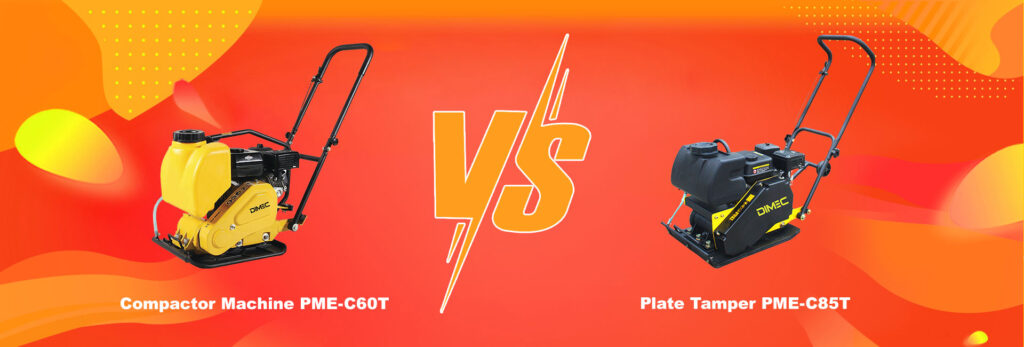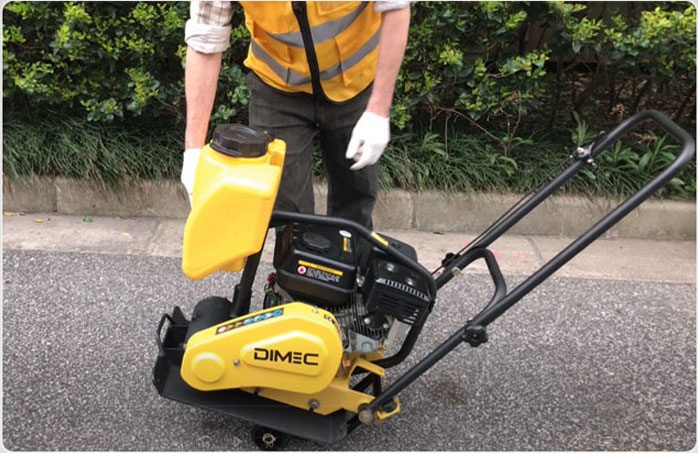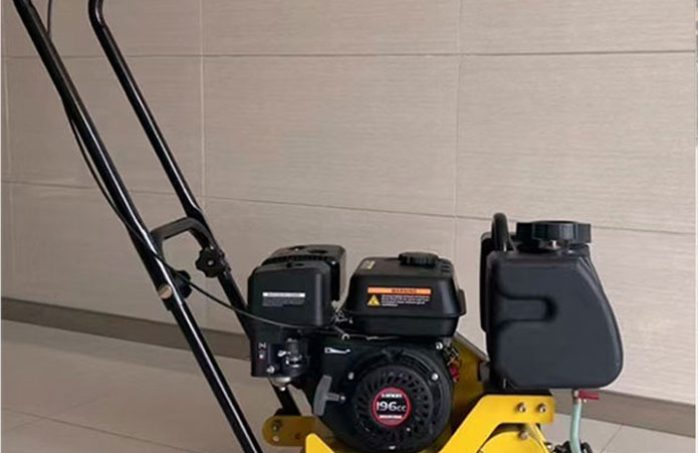Compactor Machine PME-C60T vs Plate Tamper PME-C85T: A Detailed Comparison
- DIMEC
- Compactor Machine, Plate Tamper
Home » Compactor Machine PME-C60T vs Plate Tamper PME-C85T: A Detailed Comparison

Table of Contents
Introduction
In the construction industry, selecting the right compaction equipment is crucial for ensuring efficient and effective soil compaction. The Compactor Machine PME-C60T and Plate Tamper PME-C85T are two popular models that cater to different project requirements. This article provides a comprehensive comparison of these two machines, focusing on their technical specifications, performance capabilities, and ideal applications.
Technical Specification
| Model | Compactor Machine PME-C60T |
|---|---|
| Engine | Honda / Robin / Loncin / Diesel engine |
| Engine type | Air-cooled, single cylinder, 4-stroke, petrol engine / diesel engine |
| Frequency [VPM] | 5600 |
| Centrifugal force [KN] | 12 |
| Plate size (LxW) [cm] | 50x36 |
| Max.compaction depth[cm] | 28 |
| Travel speed [m/min] | 25 |
| Max.inclination angle | 20° |
| N.W./G.W. [kg] | 68/73 |
| Package (LxWxH) [cm] | 75x38x61 |
| Model | Plate Tamper PME-C85T |
|---|---|
| Engine | Honda / Robin / Loncin / Diesel engine |
| Engine type | Air-cooled, single cylinder, 4-stroke, petrol engine / diesel engine |
| Frequency [VPM] | 4200 |
| Centrifugal force [KN] | 14 |
| Plate size (LxW) [cm] | 59x43 |
| Max.compaction depth[cm] | 30 |
| Travel speed [m/min] | 25 |
| Max.inclination angle | 20° |
| N.W./G.W. [kg] | 86/91 |
| Package (LxWxH) [cm] | 75x45x58 |
Performance Comparison
Engine Power and Efficiency
Both machines are powered by a 5.5 HP engine, providing sufficient power for demanding compaction tasks. However, the PME-C85T’s larger plate size and higher compaction force make it more suitable for large-scale projects.
Plate Size and Compaction Force
The PME-C60T has a 50 x 36 cm plate, generating a compaction force of 12 KN/sq.ft, while the PME-C85T features a larger 64 x 42 cm plate, delivering a more significant compaction force of 15 KN/sq.ft. This makes the PME-C85T ideal for projects requiring deep and uniform compaction.
Operational Speed and Coverage
The PME-C60T operates at a higher vibration frequency of 5600 VPM, allowing for faster compaction over smaller areas. In contrast, the PME-C85T, with a vibration frequency of 4200 VPM, covers larger areas more efficiently due to its larger plate size.
Applications and Ideal Projects
Compactor Machine PME-C60T
- Urban Road Repairs: Excellent for dust control and avoiding work stoppages near sensitive zones.
- Desert Solar Farms: The water tank enables compaction of dry sand without external water trucks.
- Mining Access Roads: Controls silica dust and navigates temporary haul roads effectively.
Plate Tamper PME-C85T
- Large-Scale Road Construction: Ideal for achieving deep compaction depths required for highway subgrades.
- Industrial Foundations: Suitable for heavy-duty compaction tasks in industrial settings.
- Commercial Paving: Provides high compaction force and speed, making it perfect for extensive paving projects.
Operational Considerations
Ease of Use and Ergonomics
Both machines incorporate advanced low-vibration technology and ergonomic controls to ensure operator comfort during prolonged use. The PME-C60T’s compact design makes it easier to maneuver in tight spaces, while the PME-C85T’s larger size is better suited for open areas.
Maintenance and Durability
Regular maintenance is essential for both machines to ensure peak performance. The PME-C60T has a relatively simple design, making maintenance tasks straightforward. The PME-C85T, with its more complex components, requires more frequent checks but is built to endure heavy-duty use.
Cost-Effectiveness and ROI
The PME-C60T offers excellent value for small to medium-sized projects, providing reliable performance without excessive power costs. The PME-C85T, although more expensive initially, offers significant long-term savings by reducing labor costs and project timelines in large-scale projects.
Conclusion
Choosing between the Compactor Machine PME-C60T and Plate Tamper PME-C85T depends on your project’s specific requirements. If you need a machine for dust control, urban projects, or small-scale tasks, the PME-C60T is the better choice. For large-scale, heavy-duty projects requiring deep compaction, the PME-C85T is the clear winner.
By understanding the differences in engine performance, plate size, operational speed, and application suitability, you can confidently select the machine that will ensure the success of your construction project.
FAQs
Q1: What is the main difference between the PME-C60T and the PME-C85T?
The main difference lies in their plate size and compaction force. The PME-C60T has a smaller plate and lower compaction force, making it suitable for smaller projects, while the PME-C85T has a larger plate and higher compaction force, ideal for large-scale projects.
Q2: Which machine is better for confined spaces?
The PME-C60T is better suited for confined spaces due to its smaller size and lighter weight, making it easier to maneuver in tight areas.
Q3: How do the engine powers compare between these models?
Both machines are powered by a 5.5 HP engine, but the PME-C85T’s larger plate size and higher compaction force make it more suitable for demanding tasks.
Q4: What types of projects benefit most from the PME-C85T?
Large-scale road construction, commercial paving, and high-traffic area development projects benefit most from the PME-C85T due to its deep compaction capabilities and high compaction force.
Q5: How do both machines ensure operator comfort during prolonged use?
Both machines incorporate advanced low-vibration technology and ergonomic controls to minimize operator fatigue and ensure comfort during extended use.
Feel free to contact us for any questions and doubts.
Plate Compactor X Tamping Rammer X Road Roller
Feel free to contact us for any questions and doubts
You May Also Like
Soil Compactor Roller: A Comprehensive Guide to Its Function, Benefits, and Uses
Table of Contents Soil compactor rollers are integral tools in construction and civil engineering projects. Their primary function is to compact soil and other materials to create stable, solid foundations for infrastructure like roads, buildings, and other heavy structures. This guide will explore everything you need to know about soil compactor rollers, from their types and features to their applications, maintenance, and safety considerations. Introduction to Soil Compactor Rollers What is a Soil Compactor Roller? A soil compactor roller, commonly referred to simply as a “roller,” is a large machine used to compact soil, gravel, concrete, or asphalt. The compaction process involves applying pressure to materials to reduce the amount of air between the particles, making the material denser and ...
Read More →
Single Wheel Roller: The Essential Guide for Efficient Compaction
Table of Contents Introduction to Single Wheel Roller A single wheel roller is a crucial piece of equipment used primarily in compaction projects. These machines are designed to compress, flatten, and smooth surfaces, ensuring they are solid and level. Single wheel rollers are especially valuable in construction and landscaping, where soil and materials need to be compacted to ensure stability and durability. Whether it’s for paving roads, compacting soil for foundations, or smoothing out gravel, the single wheel roller plays a key role in making surfaces more stable and long-lasting. What is a Single Wheel Roller? A single wheel roller is a compaction machine that typically features a large, heavy drum or wheel at the front. This wheel is used ...
Read More →
Ground Tamping Machine Masterclass: 21 Powerful Insights to Maximize Compaction Efficiency
Table of Contents Introduction to Ground Tamping Machines Ground tamping machines are indispensable tools in the construction and civil engineering industries. These machines ensure that the soil beneath structures, roads, or foundations is compacted uniformly, which directly impacts load-bearing strength, longevity, and structural safety. In simple terms, ground tamping machines apply repeated force to soil or other substrates to reduce air gaps and increase density. Whether you’re constructing highways or preparing a residential site, proper soil compaction is critical. In this article, we’ll cover everything you need to know about ground tamping machines—from how they work to how to choose the best one, operate them safely, and maintain them for long-term use. How Ground Tamping Machines Work Ground tamping machines ...
Read More →
Jumping Jack Rammer Powerhouse: 7 Reasons It Outperforms Every Other Soil Compactor
Table of Contents What Is a Jumping Jack Rammer? A jumping jack rammer, often called a trench rammer or tamping rammer, is a specialized soil compactor designed to deliver high-impact force in a narrow footprint. Unlike plate compactors that use vibrating motion over a broad area, jumping jack rammers use a percussive motion to compact cohesive soils like clay or silt—materials that are notoriously difficult to compact properly. These machines typically feature a vertical shaft engine, a heavy-duty spring mechanism, and a shoe (or foot) that “jumps” up and down, delivering targeted compaction force. ✅ Fun Fact: The term “jumping jack” comes from the machine’s signature motion that resembles a child’s jumping jack exercise. Why Proper Soil Compaction Matters Before ...
Read More →
Plate Compactor PME‑C50 vs Machine Compactor PME‑C80: A Comprehensive Comparison
Table of Contents When it comes to getting the perfect soil compaction, selecting the right machine is crucial. Whether you’re paving a driveway, constructing a foundation, or preparing a landscaped area, the equipment you choose will directly impact your project’s durability and efficiency. In this article, we compare two popular compaction machines from Wuxi Pinnacle Mechanical Equipment Co., Ltd.—the Plate Compactor PME‑C50 and the Machine Compactor PME‑C80. We’ll walk you through their features, performance, and applications so you can make an informed decision for your next project. Introduction So, why is soil compaction so important? Compaction stabilizes surfaces by reducing air gaps between soil particles, preventing future settling and ensuring long-term structural stability. In today’s competitive construction environment, the difference between a mediocre ...
Read More →
What is a Self Compactor and How Does It Work?
Table of Contents Introduction to Self Compactors In the world of construction and landscaping, efficiency is the name of the game. One of the essential tools that ensure projects run smoothly and structures are built on solid ground is the compactor. But among the various types of compactors, the self compactor stands out as a game changer. If you’ve ever wondered, “What is a self compactor and how does it work?”—you’re in the right place. Let’s dive into the mechanics, benefits, and applications of these remarkable machines. Types of Compactors in General Before we focus on self compactors, it’s essential to understand the broader category of compactors. They come in many forms, each designed for specific tasks: Plate Compactors: Ideal ...
Read More →
Preferred Brands of Engineering Compaction Equipment
Three Core Product Lines for Efficient Construction

Plate Compactors (40KG - 750KG)
We offer a wide range of models from light to heavy - duty. Modular design fits multiple jobs like municipal work and asphalt repair.

Tamping Rammers (32KG - 90KG)
Nine models with Honda/Robin/Loncin power. Smart fuel control and ergonomic design. Ideal for trench and slope work.

Road Rollers (0.3T - 5.5T)
Multi - level amplitude for different materials, and real - time compaction monitoring. Serve all road - building stages.

